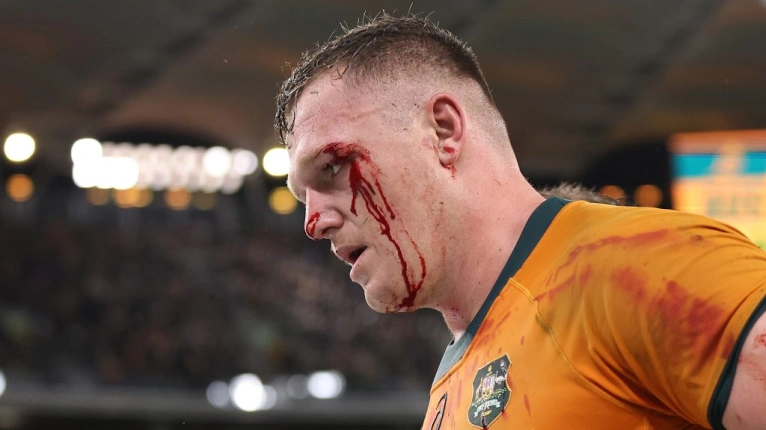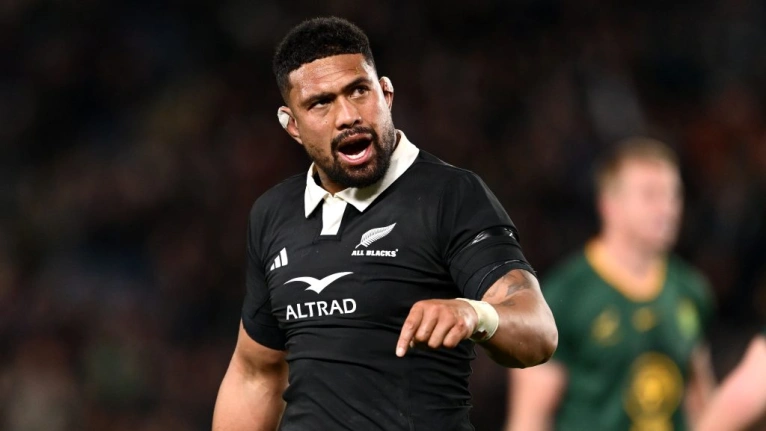The great rump of rugby views are determined by impressions. There may be a few statistics sprinkled on top, like hundreds and thousands on a Krispy Kreme donut, but the essential sweetness is still shaped by a view in real time.
When he was head coach of England, Eddie Jones once told Rugby World: “As a national coach, I’m going to games to watch players. I look to see how they react to situations, how they relate to other players, what they do off the ball.
“Most of the vision is about on the ball and I want to see what players are doing off the ball. Even if you look at the best players in the world, 90% of what they do is off the ball.”
If you pick a team based on performance off the ball, or on stats the real-time eye doesn’t usually appreciate, some of the selections will change. You may even finish up with a matchday 23 you do not recognise! Who would make the 2025 Rugby Championship team of the tournament under those rules?
Front-row
Loosehead prop: Angus Bell (Aus) starting, Ox Nche (SA) bench
Angus Bell started every one of his five TRC games off the pine but his ball-carrying load and impact was truly eye-watering.
Key Stat: Bell had the most ball-carries of any prop [averaging 14.2 per game], second among all ball-carriers behind NZ number eight Wallace Sititi, for a whopping average of 67m per game, with 4.2 tackle busts per 80 minutes of power-packed performance.
 Angus Bell has been a mighty presence at the heart of the Australian pack (Photo by Paul Kane/Getty Images)
Angus Bell has been a mighty presence at the heart of the Australian pack (Photo by Paul Kane/Getty Images)
Ox Nche’s impact was hiding in plain sight, embedded within the collective scrum stats. Together with Bell, they make the perfect prop pairing.
Key stat: Nche cannot match Bell for performance in the open, but the Springboks were +10 in scrum penalties for the tournament, far ahead of everyone else. All Nche’s opponents finished in negative equity at scrum-time – especially Francisco Coria Marchetti in round six [2.7 pens conceded per game] and Tyrel Lomax in rounds three and four [2.5 per 80].
Hooker: Malcolm Marx (SA) starting, Julian Montoya (Arg) bench
Malcolm Marx was the outstanding hooker on his return to the starting berth in the national side.
Key stat: Marx was hugely physical, scoring four tries from close-range, making the most dominant tackles for a hooker [5] and pilfering three breakdown steals [third in the comp], while being part of a dominant Bokke scrum effort.
Julian Montoya was his customary consistent self, holding a skittish Argentine scrummaging effort together in the middle of the front row.
 Argentina figurehead Julian Montoya has become a modern-day great of Pumas rugby (Photo by Mateo Occhi/Getty Images)
Argentina figurehead Julian Montoya has become a modern-day great of Pumas rugby (Photo by Mateo Occhi/Getty Images)
Key stat: The Pumas lineout was the most reliable in the competition running at 86%, despite having the shortest complement of receivers – a tribute to Montoya’s throwing arm. The hooker added 134 attacking cleanouts [second in the comp] and 30 breakdown defences [sixth].
Tighthead prop: Thomas du Toit (SA) starting, Wilco Louw (SA) bench
The selection of a resurgent Thomas ‘Tank’ du Toit and Bulls man Wilco Louw is a no-brainer on the other side of the scrum.
Key stats: The combined 280kg mass of Du Toit and Louw provided the platform for the Springboks’ +10 penalty count at scrum-time, with two further turnovers to be added when the Boks pushed first the All Blacks, then the Pumas clean off their own feeds. Between them the twin towers added 155 cleanouts, with both contributing an average of 27 attacking cleanouts apiece per game [fourth overall].
Second row
Second row: Fabian Holland (NZ) and Ruan Nortje (SA)
With most of the second-row pairings in flux – between them the four nations used 16 different locks over the six rounds – the obvious pairing was young All Black giant Fabian Holland and new Bokke lineout caller Ruan Nortje.
Key stats: With no lineout in the comp reaching the golden target of 90% retention, clean lineout ball was at a premium. Holland was the most reliable source of possession, contributing 34 takes [14 more than anyone else] at an average of nine per game. Between them Holland and Nortje added five lineout steals, with Holland the leading New Zealand tight forward tackler with 66 at an average of 17.5 per game [third overall] and Nortje contributing another 24 cleanouts per game.
Back row
Back row: Pieter-Steph du Toit (SA), Ardie Savea (NZ) and Jasper Wiese (SA) starting; Fraser McReight (Aus) and Pablo Matera (Arg) bench
There were many more outstanding candidates in the back row than in the middle row, so we will pick five back-rowers in our 23-man squad with the intention of promoting the inimitable Pieter-Steph du Toit up a row in the final half-hour.
What more needs to be said about PSDT and Ardie? Neither shows any signs of slowing down with age. They played all but 80 minutes of the tournament between them.
 Ardie Savea remains the heartbeat of the All Blacks side (Photo by Hannah Peters/Getty Images)
Ardie Savea remains the heartbeat of the All Blacks side (Photo by Hannah Peters/Getty Images)
Key stats: Savea had the most carries by any forward whether playing seven or eight [58] with Du Toit only eight carries behind, and they combined for a total of 636m and 11 successful offloads. Savea was top of the charts for breakdown pilfers with eight. Du Toit added 11 lineout takes and three more steals against the throw. Wiese was a difference-maker at number eight for South Africa midway through the competition. Wiese had the most tackle busts of any forward, averaging 5.7 per game on 14 carries for an average of 72m per game. He only conceded one penalty or turnover in the three games he played.
In the last half-hour we will shift Du Toit and bring on Queenslander McReight and Pumas talisman Matera for speed and lasting impact.
Key stats: Contributed a combined 11 breakdown pilfers, with McReight a tackle zone machine boasting 86 tackles [second in the comp] and 37 combined cleanout arrivals on both sides of the ball. Sprinkle on Matera’s 10 lineout takes and 44 carries and it is a potent final quarter mix!
Half-backs
Scrum-half: Cam Roigaard (NZ) starting, Tate McDermott (Aus) bench
Scrum-half was not a strong position for TRC 2025, but the two most promising candidates were Cam Roigard [starting] and Tate McDermott [bench].
Key stats: Roigard and McDermott were the two best running scrum-halves in the tournament, with the Hurricane averaging 52m per game and the Queenslander 39m per 80 minutes. Both averaged over four tackle busts per game and Roigard was the only player to average more than two successful offloads. The kicking game offered nice contrast with McDermott kicking the most [13.5 kicks per 80], and Roigarad the fewest [5.4].
Fly-halves: Sacha Feinberg-Mngomezulu (SA) starting, Santi Carreras (Arg) bench
The two best goal-kickers from 10 by far were Sacha Feinberg-Mngomezulu and Santi Carreras, who potted 43 of their 48 goals for a stupendous 90% success rate.
 Sacha Feinberg-Mngomezulu took the Rugby Championship by storm as South Africa’s swaggering young playmaker (Photo by PHILL MAGAKOE/AFP via Getty Images)
Sacha Feinberg-Mngomezulu took the Rugby Championship by storm as South Africa’s swaggering young playmaker (Photo by PHILL MAGAKOE/AFP via Getty Images)
Key stats: Feinberg-Mngomezulu and Carreras averaged 33 points per game, before you include their 16 average kicks out of hand, 35 total breaks or busts, and extras such as eight shared break or try assists and the Argentine’s two breakdown pilfers. So, the South African starts at 10 and Carreras covers fly-half and the back three from the bench.
Centres
Centres: Santiago Chocobares (Arg) and Jordie Barrett (NZ) starting, Joseph-Aukuso Suaalii (Aus) bench
Another hotly contested area, and finding the right synergy at 12 and 13 is the key to the success of any side. I have opted for Pumas 12 Santiago Chocobares and Jordie Barrett at 13 to start, with Joseph-Aukuso Suaalii offering x-factor and cover off the bench.
Key stats: Chocobares and Barrett were very solid in D with 85% plus tackle completion rates and sharing seven dominant hits [five of which belonged to the Kiwi]. They also combined for exactly 100 carries and 26 breaks or busts. Barrett’s kicking game is an undeniably valuable bonus [22 kicks for 612 metres]. Suaalii’s presence on the bench boosts the break/bust tally to 41 and the dominant hits to a satisfyingly round 10.
Back three
Back three: Will Jordan (NZ), Juan Cruz Mallia (Arg) and Damian Willemse (SA)
With all of the back three spots already covered by the presence of Carreras, Barrett and Suaalii, there is only space for two wings and one full-back, and they are Will Jordan and Juan Cruz Mallia out wide, with Springbok Damian Willemse at 15.
 Damian Willemse laid waste to the New Zealand defence in Wellington (Photo Joe Allison/Getty Images)
Damian Willemse laid waste to the New Zealand defence in Wellington (Photo Joe Allison/Getty Images)
Key stats: Willemse was the only member of the back three to average over 100m gained per 80 minutes, compared to Jordan’s 76m and Mallia’s 84m. Jordan offers the burning speed and breaking ability [six breaks and 18 tackle busts] while Willemse and Mallia provide the all-rounder, extra playmaking ability with 28 kicks and 15 offloads between them.
Summary
The final balance reflects the true balance of power in 2025: nine Springboks, five players apiece from Argentina and New Zealand, and four from Australia.
A tight five weighted towards the world champions, with a mix of Argentine and Kiwi strike runners to fire the bullets and South Africa’s brand-new playmaking axis to supply the ammunition. Martians beware – planet earth, or at least the southern half of it, is ready and raring to go!

